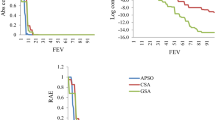Abstract
The Karmarkar-Karp differencing algorithm is the best known polynomial time heuristic for the number partitioning problem, fundamental in both theoretical computer science and statistical physics. We analyze the performance of the differencing algorithm on random instances by mapping it to a nonlinear rate equation. Our analysis reveals strong finite size effects that explain why the precise asymptotics of the differencing solution is hard to establish by simulations. The asymptotic series emerging from the rate equation satisfies all known bounds on the Karmarkar-Karp algorithm and projects a scaling n −c ln n, where c = 1/(2 ln 2) = 0.7213 .... Our calculations reveal subtle relations between the algorithm and Fibonacci-like sequences, and we establish an explicit identity to that effect.
Similar content being viewed by others
References
N. Karmarkar, R.M. Karp, The differencing method of set partitioning. Technical Report UCB/CSD 81/113, Computer Science Division (University of California, Berkeley, 1982)
S. Mertens, C. Moore, The Nature of Computation (Oxford University Press, Oxford, 2008)
M.R. Garey, D.S. Johnson, Computers and Intractability. A Guide to the Theory of NP-Completeness. edited by W.H. Freeman (New York, 1997)
H. Bauke, S. Mertens, A. Engel, Phys. Rev. Lett. 90, 158701 (2003)
R.C. Merkle, M.E. Hellman, IEEE Trans. Info. Th. 24, 525 (1978)
S. Mertens, Phys. Rev. Lett. 84, 1347 (2000)
C. Borgs, J. Chayes, B. Pittel, Rand. Struct. Alg. 19, 247 (2001)
B. Derrida, Phys. Rev. Lett. 45, 79 (1980)
B. Derrida, Phys. Rev. B 24, 2613 (1981)
H. Bauke, S. Mertens, Phys. Rev. E 70, 025102(R) (2004)
A. Bovier, I. Kurkova, Commun. Math. Phys. 263, 513 (2006)
A. Bovier, I. Kurkova, J. Stat. Phys. 126, 933 (2007)
I. Kurkova, Elect. J. Probability 13, 5 (2008)
B. Yakir, Math. Oper. Res. 21, 85 (1996)
J. Kleinberg, É. Tardos, Algorithm Design (Addison Wesley, Boston, 2006)
D.S. Johnson, C.R. Aragon, L.A. McGeoch, C. Schevron, Operations Research 39, 378 (1991)
W. Ruml, J.T. Ngo, J. Marks, S.M. Shieber, J. Opti. Th. Appl. 89, 251 (1996)
R.E. Korf, Art. Intell. 106, 181 (1998)
R.H. Storer, S.W. Flanders, S.D. Wu, Annals of Operations Research 63, 465 (1996)
G.S. Lueker, Oper. Res. Lett. 6, 285 (1987)
The GNU Multiple Precision Arithmetic Library. http://gmplib.org
TRNG — portable random number generators for parallel computing. http://trng.berlios.de
W. Feller, An Introduction to Probability and Its Applications, 2nd edn. (John Wiley & Sons, 1972) Vol. 2
N.J.A. Sloane, The on-line encyclopedia of integer sequences http://www.research.att.com/~njas/sequences
C. Moore, P. Lakdawala, Phys. D 135, 24 (2000)
C.M. Bender, S.A. Orszag, Advanced Mathematical Methods for Scientists and Engineers (McGraw-Hill, New York, 1978)
Author information
Authors and Affiliations
Corresponding author
Rights and permissions
About this article
Cite this article
Boettcher, S., Mertens, S. Analysis of the Karmarkar-Karp differencing algorithm. Eur. Phys. J. B 65, 131–140 (2008). https://doi.org/10.1140/epjb/e2008-00320-9
Received:
Revised:
Published:
Issue Date:
DOI: https://doi.org/10.1140/epjb/e2008-00320-9




